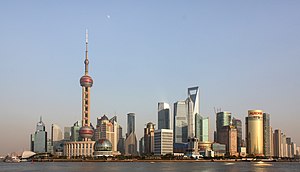Shanghai (Chinese: 上海, Shanghainese pronunciation: [zɑ̃.hɛ] (![]() listen); Mandarin pronunciation: [ʂâŋ.xài] (
listen); Mandarin pronunciation: [ʂâŋ.xài] (![]() listen)) is the biggest city in China and one of the world's largest cities. It had about 24,000,000 people in 2017. It is a special province-level city in China ("municipality"), like Beijing, Tianjin, and Chongqing.
listen)) is the biggest city in China and one of the world's largest cities. It had about 24,000,000 people in 2017. It is a special province-level city in China ("municipality"), like Beijing, Tianjin, and Chongqing.


Name
changeThe Mandarin Chinese name of Shanghai is Shànghǎi,[a] which is written as 上海 in Chinese characters. This name means "On-the-Sea" because Shanghai used to be next to the East China Sea. Today, dirt from the Yangtze River has made Pudong much bigger and downtown Shanghai is about 40 kilometers (25 mi) from the open sea. The city has become so big, though, that its government now controls other areas like Pudong and Fengxian that are still beside the sea.
Shanghai's name is a little simpler than most other Chinese cities' names, because it was a small fishing village for a long time. The short way to say its name in Chinese is still Hù[a] (沪). A hu was an old kind of fishing trap that was made with bamboo and nets. The people around Shanghai used to use them to catch fish and crabs in Suzhou Creek and other waterways.
Geography
changeShanghai is at the mouth of the Yangtze River, where it meets the East China Sea in the middle of China's east coast. Downtown Shanghai is located just south of the place where Suzhou Creek meets the Huangpu River. This is about 20 kilometers (12 mi) southwest of where the Huangpu meets the Yangtze River. The area between downtown and the Yangtze used to be farmland and other cities like Wusong and Baoshan, but now Shanghai is so big that they are part of it.
History
changeFor most of China's history, Shanghai was a small fishing village. The big cities nearby were Suzhou and Hangzhou. Under the Ming and Qing, Shanghai had a big city wall and started to grow.
Under the Ming and the Qing, people from other countries could only buy and sell things with China on an island near Guangzhou. The British effectively controlled Shanghai from the mid 19th century until World War II. Parts of Shanghai were controlled by the UK, the US, and France. This control was ended by the Japanese during World War II.
The Chinese Communist Party was founded in Shanghai.
Landmarks
changeShanghai attracts many tourists each year. Its landmarks include:
Amusement parks
changeShanghai Disneyland Park, Happy Valley, Jinjiang Amusement Park
Commercial Centers
changeHuamu, Lujiazui, Wujiaochang, Xintiandi, Xujiahui, Zhenru
Culture venues
changeHongkou Football Stadium, Pudong Football Stadium, Shanghai Library, Shanghai Grand Theater, Tianzifang arts, crafts, and folklore
Gardens
changeMuseums
changeShanghai Science and Technology Museum, China Art Museum, Shanghai Natural Museum,
Nature
changeSheshan, Shanghai Ocean Aquarium, Shanghai Wildlife Park
Sightseeing locations
changeEast Nanjing Road, People's Square, Site of the First CPC National Congress, The Bund, Zhujiajiao
Temples
changeCity God Temple of Shanghai, Confucian Temple of Shanghai, Jing'an Temple, Jade Buddha Temple, Longhua Temple, Zhenru Temple
Towers
changeShanghai World Financial Center, Oriental Pearl Tower, Shanghai Tower, Jinmao Tower
Business
changeShanghai is home to the China Stock Exchange, along with Shenzhen, and is the financial center of China.
Sister Cities
changeRelated pages
changeNotes
changeReferences
changeOther websites
change- Official website Archived 2008-05-02 at the Wayback Machine